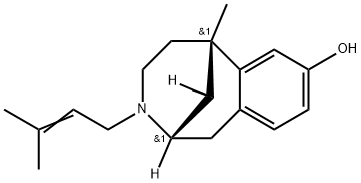PENTAZOCINE

- CAS No.
- 359-83-1
- Chemical Name:
- PENTAZOCINE
- Synonyms
- Lexir;C07421;II-C-2;Talwan;Talwin;Fortral;KF-1820;Liticon;nih7958;sosegon
- CBNumber:
- CB1121418
- Molecular Formula:
- C19H27NO
- Molecular Weight:
- 285.43
- MOL File:
- 359-83-1.mol
- Modify Date:
- 2025/1/27 9:38:02
| Melting point | 145.4-147.20C |
|---|---|
| Boiling point | 427.85°C (rough estimate) |
| Density | 1.0104 (rough estimate) |
| refractive index | 1.5180 (estimate) |
| Flash point | 9℃ |
| storage temp. | Controlled Substance, -20°C Freezer |
| solubility | DMSO: >10mg/mL |
| pka | pKa 8.68±0.05;11.23± 0.05(H2O,t =20,I=0.1) (Uncertain) |
| form | solid |
| color | white |
| CAS DataBase Reference | 359-83-1 |
| EPA Substance Registry System | 2,6-Methano-3-benzazocin-8-ol, 1,2,3,4,5,6-hexahydro-6,11-dimethyl-3-(3-methyl-2-buten-1-yl)-, (2R,6R,11R)-rel- (359-83-1) |
SAFETY
Risk and Safety Statements
| Symbol(GHS) |  GHS07 |
|||||||||
|---|---|---|---|---|---|---|---|---|---|---|
| Signal word | Warning | |||||||||
| Hazard statements | H302 | |||||||||
| Precautionary statements | P264-P270-P301+P312-P501 | |||||||||
| Hazard Codes | Xn,T,F | |||||||||
| Risk Statements | 22-39/23/24/25-23/24/25-11 | |||||||||
| Safety Statements | 7-16-36/37-45 | |||||||||
| RIDADR | UN1230 - class 3 - PG 2 - Methanol, solution | |||||||||
| WGK Germany | 3 | |||||||||
| RTECS | PB8750000 | |||||||||
| HS Code | 2933330000 | |||||||||
| Hazardous Substances Data | 359-83-1(Hazardous Substances Data) | |||||||||
| Toxicity | LD50 s.c. in male rats: 175±36 mg/kg (Goldenthal) | |||||||||
| NFPA 704 |
|
PENTAZOCINE Chemical Properties,Uses,Production
Chemical Properties
Crystalline Solid
Uses
(?)-Pentazocine is a benzomorphan-type opiate with analgesic properties. It binds to opioid receptors (Ki values = 7.2, 31, and 5.7 nM for κ-, δ-, μ-opioid receptors, respectively) and to the type 1 σ-receptor (Kd = 12 nM). (?)-Pentazocine is abused with methylphenidate and other drugs. It is regulated as a Schedule IV compound in the United States. This product is intended for forensic and research applications.
World Health Organization (WHO)
Pentazocine, which has both agonist and weak opioid antagonist activity, was introduced in 1967 for the treatment of moderate and severe pain. The risk of drug dependence is lower with pentazocine than with morphine-like drugs and pentazocine has been controlled under Section III of the 1971 Convention on Psychotropic Substances since 1984. The risk of dependence is now widely acknowledged to exist in vulnerable individuals and at least one country has applied controls analogous to those of Schedule I of the 1961 Single Convention on Narcotic Drugs. (Reference: (UNCPS3) United Nations Convention on Psychotropic Substances (III), , , 1971)
General Description
The benzomorphans are prepared synthetically and thus resultin several stereoisomers. The active benzomorphans arethose that have the equivalent bridgehead carbons in thesame absolute configuration of morphine (carbons 9, 13,and 14 of morphine). The only benzomorphan in clinical useis pentazocine, which is prepared as the 2(R), 6(R), 11(R)enantiomer (Chemical Abstracts numbering). Pentazocineis a mixed agonist/antagonist displaying differing intrinsicactivity at the opioid receptor subtypes. At the κ-receptor,pentazocine is a partial agonist and a weak antagonist.
According to the manufacturer, a 50-mg dose of pentazocinehas about the same analgesic potency as 60 mg of codeineand about 1/50th the antagonistic activity of nalorphine.74Pentazocine is also an agonist at the κ-receptor, and thismay be responsible for the higher percentage of patients thatexperience dysphoria with pentazocine versus morphine.75Some evidence also exists that women respond better to κ-agonists than men. Pentazocine is available in a 50-mgtablet along with a low dose of the antagonist naloxone 0.5mg (Talwin NX). Naloxone 0.5 mg orally is expected tohave no pharmacological effect but is included to dissuadeIV drug abusers from dissolving and injecting Talwin NX.
Safety Profile
Poison by ingestion, subcutaneous, intramuscular, intraperitoneal, and intravenous routes. Experimental reproductive effects. Human systemic effects by intramuscular and intravenous routes: wakefulness, euphoria, hallucinations or distorted perceptions, tremors, convulsions, excitement, motor activity changes, muscle weakness, analgesia, withdrawal, parasympathomimetic effects, nausea or vomiting, and dernlititis. Can cause drug dependency and other central nervous system effects, An analgesic. When heated to decomposition it emits toxic fumes of NOx. See also ALLIT COMPOUNDS.
PENTAZOCINE Preparation Products And Raw materials
Raw materials
1of2
chevron_right




